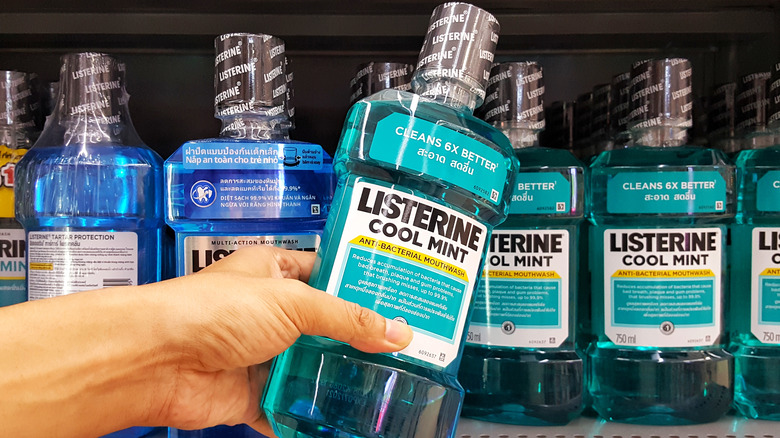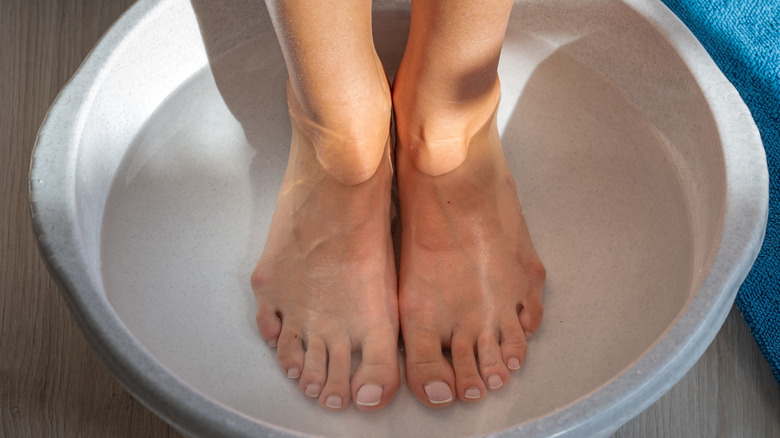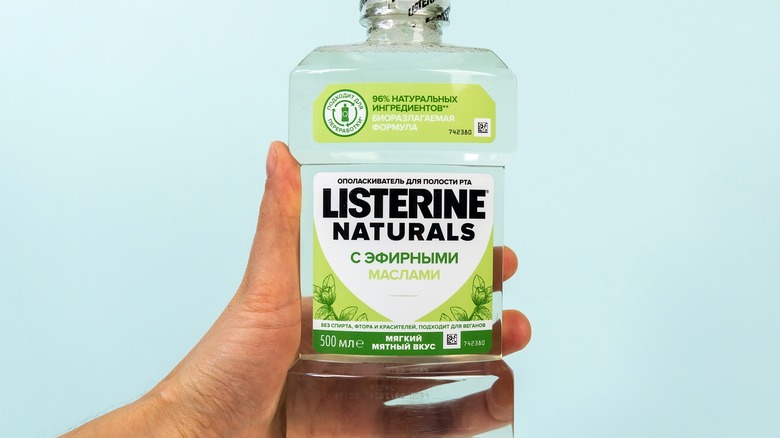What Is A Listerine Foot Soak And Does It Work?
When someone mentions the word "Listerine," the response that follows is usually "mouthwash." Containing the substance menthol, Listerine has been known to destroy destructive breath germs, prevent cavities, reduce plaque, strengthen tooth enamel, and keep the breath fresh, per Listerine's official website. Boasting tremendous benefits for oral hygiene, fluoride mouthwash like Listerine has become a staple in almost every household's daily routine. Because the image of Listerine is indelibly linked with the mouth, it's hard to believe that this old-school liquid commonly used for teeth and gum rinsing can also be used for foot soaking.
According to The Podiatry Center, bathing your foot in Listerine for at least 30 minutes a day can help you get rid of toenail fungus, among other foot diseases. The antifungal characteristics of menthol and thymol, the liquid's major constituents, are said to be what makes the liquid a must-have for home cures for fungal infections of the mouth and foot. Here's why Listerine is believed to make your feet minty fresh and healthy, just like it does your mouth.
How to make an at-home Listerine foot soak
Listerine consists of essential oils packed with alleged antiseptic properties such as eucalyptol, menthol, thymol, and methyl salicylate, which are believed to be able to lessen the growth of fungal organisms and bacterial species, per a study published in The Bulletin of Tokyo Dental College. Among them, methyl salicylate is used in numerous topical pain relief treatments. Because of its disinfectant qualities, people use Listerine in the treatment of athlete's foot, a fungal infection that causes itchiness, and toenail fungus, a condition that causes discoloration and cracks in the nail. This famous mouthwash is purportedly also able to slough off dead skin from the feet or toes and moisturize cracked heels.
Dipping infected feet or toes in Listerine mixed with water for about 20 minutes twice a day helps soften the nail plate, allowing the thymol to get inside and destroy the fungus, dermatologist Dr. Tsippora Shainhouse tells Byrdie. In case you have only one infected nail or are short on time, you can apply a cotton ball soaked in Listerine directly to the nail. You can use a Listerine foot soak on a daily basis until your condition clears up along with your prescribed infectious treatments, or simply use it as a preventative measure. While Listerine has purported effectiveness against fungal infections in the foot, studies on the antibacterial properties of Listerine concentrated more on its benefits for oral care.
Listerine foot soaks are not for everyone
Foot soaks, while reasonably safe, may not be the best option for everyone suffering from foot disease. For instance, those with sensitive skin might sustain mild irritation from a Listerine soak, Healthline cautions. If you're planning to try a Listerine or vinegar foot soak at home, you might want to test the solution on a small patch of your skin first before dipping your whole feet in the tub. If you have athlete's foot, Listerine foot soaks or other types of self-treatment may not be enough to get rid of it. Consider visiting to the pharmacy to get antifungal lotions or tablets if you notice painful and flaky spots, bleeding, or cracks on your feet or toes. To be extra sure, send a small patch of skin from your feet to a laboratory for a proper diagnosis or seek help from a skin specialist for more advanced treatment, the U.K.'s NHS advises. Try not to wait until many days of foot soaks fail to work before going to a doctor for a prescription.
Though no scientific research has been conducted on Listerine as a helpful remedy for foot infections, anecdotal accounts from internet sources indicate that Listerine foot soaks have multiple good effects with few negative effects. Simply put, a Listerine foot soak doesn't hurt you, but neither is it decisively proven to help you cure a fungal skin infection. To err on the safe side, speak with a healthcare professional before using a diluted Listerine to bathe your foot. Another thing to keep in mind is that an ounce of prevention is better than an ounce of cure. To prevent excessive sweating and fungal infections, keep your feet dry at all times and change your socks on a regular basis.


